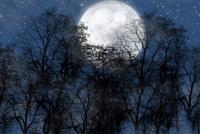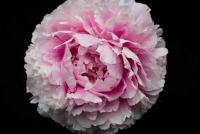Yellow barberry. Types of barberries
It grows on the open mountain slopes of Japan and China.
V. thunbergii "Diabolicum"
Photo Skorodumovoy Tatiana
The most beautiful of deciduous barberries (up to 0.5-1 m in height), with horizontally extending, densely branched shoots, arcuately deflected, yellowish, bright red or purple-red, later purple-brown or brown in youth. Spines up to 1 cm long, simple, thin and elastic. The leaves are small (1-3 cm), graceful, obovate or oblong, tapering to the base and turning into a short petiole, bright green above and bluish below. In autumn, they are painted in bright red colors, fall in October. Flowers solitary or in bunches of 2-5, reddish on the outside, yellow on the inside, bloom for 8-12 days. The fruits are coral-red, shiny, elliptical, up to 1 cm long, ripen in early autumn and do not fall for a long time. Fruiting annual, quite abundant. Unfortunately, the barberry fruits of this species are bitter, as they contain many alkaloids, and are not suitable for food, but this is an excellent food for birds that overwinter with us.
Collection pl., Cleaning with. from the pulp, storage conditions are the same as that of B. aggregata. When spring crops need stratification at 1 - 5 ° C for 3 - 4 months. You can sow in the fall in the square. immediately after collection or peeled off with. without stratification. Sowing depth with. 2 - 3 cm. Seed viability of 92%. Rooted 80-90% of summer cuttings.
 V. thunbergii "Red Chief" The photo EDSR. |
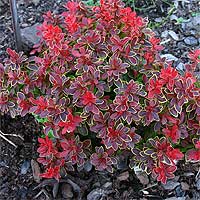 V. thunbergii "Admiration" Photo of Yuri Bazhenov (Green Line) |
V. thunbergii "Red Carpet" Photo of Yuri Bazhenov (Green Line) |
In harsh winters, the non-woody part of the shoots froze. It is better to cover young plants for the winter, moderately gas-and smoke-resistant, is not affected by rust at all. The soil is undemanding, quite drought-resistant. It tolerates a haircut. Due to its spiny nature, the plant is often used to create impassable hedges, and powerful branched roots can strengthen any, even the steepest slope. Usually propagated by seeds that have previously undergone a three-month stratification.
Universal plants for use in the landscape. They can be planted in rocky gardens and on the banks of reservoirs. They are relevant to ceremonial places and landscape compositions. If the plants are planted after 40-50 cm, then over time a low excellent hedge is obtained. Good as accents in dwarf compositions and constituent elements in larger ones. Can be planted in rabatki among perennial flowers. From the variety "Bagatelle", for example, it turns out a great border. "Atropurpurea" is used as low hedges and borders, in single and group plantings and in the form of sheared forms. Especially spectacular in the autumn due to the intense color of the leaves and bright fruits. In a low-trimmed border, in cold areas, it is successfully replaced by a heat-loving boxwood. In culture since 1864.
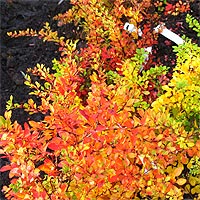 Photo by Yuri Bazhenov (Green Line)
Photo by Yuri Bazhenov (Green Line)
It has several decorative forms: many-flowered(f. pluriflora) - up to 10 flowers in inflorescence; dark purple (f. atropurpurea) - with dark purple leaves, although it is less winter-hardy than the main species, but its decorative advantages are so great that in some cases it is advisable to even cover the plants for the winter; silver-edged (f. argenteo-maiginata) - with a silver border around the edge of the sheet.
var. maximowiczii (Regel) Regel- B.T. Maksimovic. In GBS since 1957, 2 samples (4 copies) were grown from seeds obtained from the culture, there are plants of seed reproduction of GBS. Shrub, 10 years old, height 1.0 m, crown diameter 160 cm. Vegetation from late April to late October. It grows slowly. Flowering and fruiting from 5 years annually. It blooms in late May-early June, about 10-12 days. The fruits ripen in early October. Full winter hardiness. Seed viability of 90%. Rooted 80% of summer cuttings. In landscaping absent.
var. uniflora Koehne - B.T. single-flowered. In GBS since 1975, 1 sample (3 copies) was grown from seeds. Shrub, at 7 years old, height 1.4 m, crown diameter 150 cm. Vegetation from late April to second half of October. It grows slowly. Flowering and fruiting from 6 years annually. It blooms in late May-early June, about 12 days. The fruits ripen in early October. Winter hardiness I. Seed viability of 75%. Full winter hardiness. Seed viability 75%. Rooted cuttings of 50% of the summer. In landscaping absent.
f. "Minor". In the GBS since 1960, 1 sample (1 copy) was grown from seeds. Shrub, at 8 years old height 0.3-0.6 m, crown diameter 60 cm. Vegetation from late April to mid-October. It grows slowly. It blooms in late May-early June, about 12 days, annually. The fruits ripen in early October. Winter hardiness is below average. Seed viability 75%. Rooted 33% of summer cuttings. In landscaping absent.
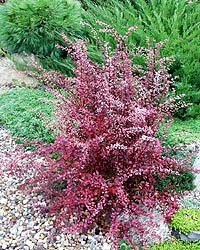 V. thunbergii "Harlekin" |
 V. thunbergii "Erecta" |
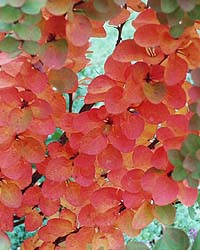 V. thunbergii "Erecta" |
| Photos by Anna Petrovicheva | ||
Dwarf varieties (especially valuable): "Kobold" - up to 40 cm tall, with green leaves; "Minor" - up to 50 cm tall, with green leaves; "Aurea" - with yellow leaves; "Atropurpurea Nana" = "Crimson Pygmy" - up to 60 cm and "Bagatelle" - up to 40 cm, both with beet leaves.
Tall varieties with green leaves: "Erecta" - narrow, columnar bush up to 1.5 m; "Green Carpet" - a wide bush, flattened; "Green Ornament" - dense bush, leaves remain dark green until late autumn; "Vermillion" - with exceptionally bright autumn leaf color.
Tall varieties with red and maroon leaves: "Atropurpurea" - the highest, up to 1.5 m; "Golden Ring" - with a narrow yellow edge of the sheet; "Dart" s Red Lady "- with very bright purple leaves;" Red Chief - relatively tall, with very bright narrow leaves; "Helmond Pillar" and "Electra" - a bush of narrow, columnar shape.
Varieties with pink speckles on the leaves: "Harlequin" - with purple leaves with large pink spots; "Pink Queen" - with almost red young leaves, subsequently darkening, abundantly sprinkled with gray and white, the best of the group of pink and variegated varieties; "Rose Glow" - an old variety with purple leaves on young shoots, flecked with large white, pink and hot pink spots; "Rozetta" - with leaves containing more pink in color than white spots.
Varieties with white mottling on the leaves: "Silver Beauty" - with a slight increase; "Kelleriis" - larger and more powerful, in the fall stains remain white on rosy leaves.
 Berberis thunbergii The photo Sophia Zhelezova |
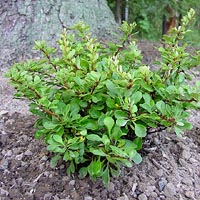 Berberis thunbergii "Kobold" The photo Olga Bondareva |
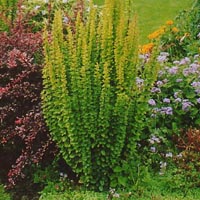 Berberis thunbergii "Erecta" The photo Anna Petrovicheva |
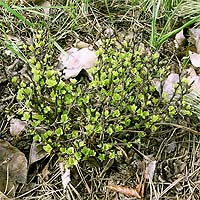 Berberis thunbergii "Tiny Gold" Photography Borsyakova Lena |
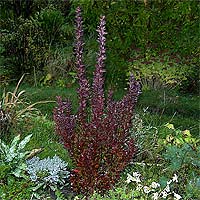 Berberis thunbergii "Red Pillar" Photography Borsyakova Lena |
 Berberis thunbergii "Golden Nugget" Photo Ganova Andrew |
Below are the characteristics of the most famous overseas varieties.
"Harlequin"("Harlequin") - shrub 1.2-1.5 m high and 1.2 m in diameter. Annual growth of up to 10-15 cm per year. Young shoots are red. The leaves are red with pink and white spots. Yellow flowers appear in May and effectively stand out against the background of variegated foliage. Variety is similar to " Rose glow"but with a different shade of leaf color and lots of mottled spots."
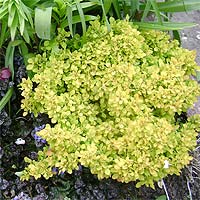 Berberis thunbergii "Tiny Gold"
Berberis thunbergii "Tiny Gold"
Photo by Alexander Zhukov
"Atropurpurea"("Atropurpurea") - shrub 1.5-1.8 m tall, leaves all season remain purple-red-brown. Vegetation from late April to mid-October. It grows slowly. It blooms in early June, about 12 days. The fruits ripen in early October. Winter hardiness I. Seed viability of 90%. Rooted 100% summer cuttings.
"Atropurpurea Nana" ("Atropurpurea Nana", synonyms "Crimson Pygmy", "Kleiner Favorit", "Little Favorite") is a shrub up to 0.6 m high and with a crown diameter of about 1 m. The crown is compact, pillow-shaped. The bark is reddish brown. On the shoots triple split thorns. The leaves are ovate, 1–2 cm long, purple-red, scarlet-red in autumn. Blossoms in May. Flowers with a diameter of up to 1 cm, inside are yellow, outside are red, are collected in brushes of 2 -5 pieces. Fruits are bright red, shiny, ripen in October, remain on the branches in winter.
"Aurea" ("Aurea") - shrub up to 0.8 m high, crown diameter 1 m. Crohn rounded. Young shoots are yellowish-green. There are single spikes. Leaves from lemon yellow to golden yellow shades. Their autumn color is yellowish-orange. Blossoms in May. Flowers up to 1 cm in diameter, yellow inside, red outside, clustered in brushes or bunches of 2 -
5 pieces The fruits are bright red, shiny, ripen in September - October. Saved on the branches in winter. Rooted 65% of summer cuttings.
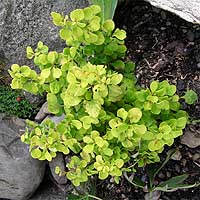 Berberis thunbergii "Bonanza Gold" Photo EDSR. |
 Berberis thunbergii ‘Bagatelle’ Photo EDSR. |
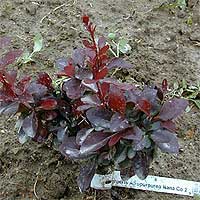 Berberis thunbergii "Atropurpurea Nana" Photo of Severyakova Elena |
"Bonanza Gold" ("Bonanza Gold") - amazing beautiful shrub with a very dense, dense, pillow crown. Height 50 cm, diameter 70 cm. The leaves are very small, light lemon-golden, even in cloudy weather it seems that the bush is consecrated by the sun.
"Bagatelle" (‘Bagatelle’ (‘Kobold’ x ‘Atropurpurea Nana’)) - a charming low shrub with a height and crown diameter of up to 0.4 m. Justifies its French name - “trinket”. The krone is compact, low. Annual growth of about 2 cm. Bark red-brown. Leaves ovate, up to 1.5 cm in length, brownish in summer and scarlet-red in autumn. Fruits are bright red, shiny, edible, ripen in October. It is rather hard, but easily recovered by the beginning of June.
"Helmond Pillarr" ("Helmond Pillarr") - shrub up to 1.5 m high and 0.4-0.5 m wide, reaches such sizes after 8-10 years of cultivation in one place. A narrow, almost columnar shrub with rounded foliage. Pink-red young leaves and rich purple - the old perfectly harmonize with each other.
Golden Ring - launched in 1950 by Lombarts. The height of the bush and the diameter of the crown 2 - 3 m. The crown is rounded. Leaves ovate, up to 4 cm long, dark purple-red, yellow-edged. Autumn leaves are intensely red. Blossoms in May. The flowers inside are yellow, outside are red, with a diameter of up to 1 cm, are collected in bunches of 2 - 5 pieces each. The fruits are coral-red, shiny, ripen in October.
 Berberis thunbergii "Carmen" |
 Berberis thunbergii "Powwow" Photo of Vladimir Epictetov |
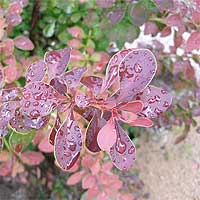 Berberis thunbergii "Golden Ring" Photo EDSR. |
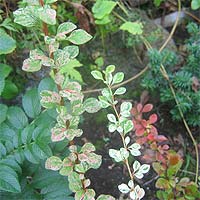 Berberis thunbergii "Kelleris" Photo Ganova Andrew |
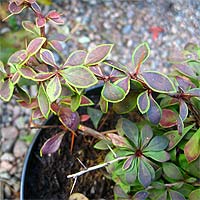 Berberis thunbergii "Coronita" Photo Ganova Andrew |
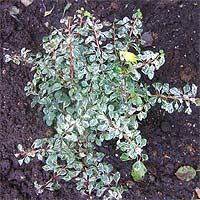 Berberis thunbergii "Starburst" Photo Ganova Andrew |
"Green Carpet" ("Green Carpet") - the height of the bush is 1 m, the diameter of the pillow crown is 1.5 m. The bark is brown-yellow. Spines are tripartite. The leaves are light green in summer, scarlet-red in autumn. Blossoms in May. The flowers inside are yellow, the outside is red. Fruits are pink or red, up to 1 cm in diameter.
"Green Ornament" - shrub having a height and diameter of the crown up to 1.5 m. The crown is round, compact. The bark is brown-yellow. Spines are tripartite. The leaves are round to elliptical, up to 3 cm long, blooming is yellow-green, then bright green, in the fall - brownish-yellow. Blossoms in May. The flowers are yellow. Fruits are light red.
"Darts Red Lady" ("Dart" s Red Lady ") - globular-shaped shrub, up to 80 cm tall. The leaves are maroon-purple, brilliant. The young growth is lighter and brighter. In autumn, the color turns yellow. It is used for a beautiful colored spot in colorful compositions and as a high ground cover.
Kelleris ("Kelleriis"). Wide sprawling shrub, leaves covered with creamy white spots and strokes. In autumn, the white part of the leaf acquires shades from pink to deep dark red.
"Kobold" ("Kobold") - height and diameter of the crown of the bush to 0.5 m. The crown is spherical, compact. The bark is reddish brown. Spines are tripartite. The leaves are ovate, up to 1.5 cm in length, in summer dark green, shiny, in autumn yellow or scarlet-red. Blossoms in May. Flowers up to 1 cm in diameter, yellow inside, red outside, collected in small inflorescences. Fruits are pink or red, edible.
"Kornik" ("Kornik"). The original deciduous shrub up to 1.5 m. The leaves are small pale green, covered with chaotically located cream-white spots of various shapes, as if stained with paint. The drawing is also preserved in the autumn period, when the leaf blades are painted in shar-lahovo-red tones. In warm climates, it is rather unpretentious, and harsh winters endure poorly. After sanitary pruning, it recovers quickly, but next season it freezes again, which, as a rule, does not bloom and rarely exceeds a meter height. Drought-resistant, undemanding to soil fertility. It prefers a sunny place where the spots on the leaves become brighter and larger, as well as breathable, loose soil. Shelter for the winter is recommended. The unusual color of the leaves allows you to use it as a spectacular accent in the composition. It looks great with conifers, roses, as well as alongside other species and barberry varieties.
"Maria" ("Maria") is a new Polish variety, similar to the Aurea variety, but with stronger growth. Due to the straight reddish ends of young shoots and golden-yellow leaves with carmine edge, the variety is very decorative.
Pink Queen(‘Pink Queen’, synonym for V. t. Atropurpurea Rosea) - bush is sprawling, up to 1.25 m. Young leaves are red, later brown-red with pink-red and gray strokes, carmine-red in autumn. The best of pink colored varieties. From a distance, the plant looks pink. Looks like a Harlequin variety.
"Red Pilar" ("Red Pillar") is one of the most attractive vertical column-shaped forms (1.5 m high and 45 cm wide). Its reddish-purple leaves become scarlet in autumn. Perfect for creating low hedges, but with age, the bush can fall apart.
"Red Chef"(‘Red Chief’) is a shrub with a height and crown diameter up to 4 m. The crown is spreading with drooping branches. The bark is red-brown. Spines are tripartite, up to 2 cm in length. Leaves lanceolate to obovate, up to 3.5 cm long, purple-brown-red in summer and scarlet in autumn. Blossoms in May. The flowers are yellow. The fruits are pink and red. A very attractive plant, but in Moscow conditions, annual shoots freeze slightly. Wintering young weak plants is recommended with cover. Rooted 20-30% of summer cuttings. Looks impressive next to other species and varieties of barberry, for example, with a yellow-leaved variety b. Toonberg "Aurea", and tamped with creeping junipers.
"Rose Glow"("Rose Glow", a synonym for V. t. "Ida") - shrub 1.2-1.5 m in height and 1.2 m in diameter. Annual growth of up to 10-15 cm per year. Young leaves with a marble bronze-red and pink-white pattern, the old - dark pink and red-purple. Yellow flowers appear in May and stand out effectively against the background of variegated foliage. Strikingly colorful bush. There is a similar one to it. " Rosetta"(" Rosetta ") - shrub with pink and white spots on a burgundy background.
"Silver Beauty" ("Silver Beauty", a synonym for V. t. "Argenteo-Marginata"). Slow-growing shrub (about 1.5 m in height, 1 m wide reaches 10 years after planting) with silver-motley leaves and the same border. Sometimes at the end of the season pink and dark red spots appear on the leaves. Seed viability of 60%. Rooted 100% summer cuttings. This form is similar to "Kelleriis", less vigorous, but more interesting. You can also offer a beautiful shrub barberry Ottawa "Silver Miles".
Barberry Thunberg has such varieties as " Red king"whose leaves are dark red, and the bush is more compact than the original form;" Dart "s purple"with brownish-red leaves, up to 1 m tall;" Red rocket"with a strictly vertical crown shape and red-brown foliage.
The above varieties are low-resistant, but when planted in sheltered places and shelter for the winter of young plants with leaf and spruce leaves successfully survive in the middle zone of Russia.
Very decorative - the leaves are purple, and the flowers are yellow-red. In the autumn season, the plant is especially attractive - the leaves become saturated purple in color. Flowering occurs in the first decade of May and lasts about 14 days.
Sorta
Barberry Ottawa boasts only three varieties:

Amur barberry: description, characteristic
This type of barberry is less popular. Perhaps this is due to the fact that some bushes can grow quite high - up to 3.5 m. It tolerates dry periods, but can freeze in severe frosts. In summer, the leaves have a rich green color, and in the autumn season golden-red. Flowering usually occurs at the end of May.
Main varieties
To date, only two varieties of this variety are known:
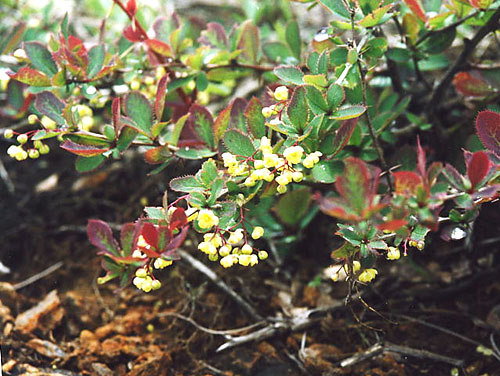
This type of barberry does not end there. There is, for example, the Siberian barberry. Each species is unique in its own way. Each has its own characteristics and characteristics. The choice of species of barberry depends on the purpose of the gardener.
Add, barberry due to its simplicity and decorative at the same time, is very popular. It is planted in parks, gardens, cottages. The plant gives the territory a sophisticated and sophisticated look. In hot weather, such plantings exude a tart and at the same time sweetish aroma. By the way, note gardeners. Barberry is a wonderful honey plant. Therefore, along with buckwheat and lime, there is still not inferior - barberry honey.
Barberry for the garden - video
If the size of the plot allows, gardeners are engaged in the cultivation of not only popular fruit trees and shrubs. Increasingly in the garden appears barberry, represented by several species. Each of them includes many varieties, represented by the original names. Today we will find out what this culture is and evaluate the photos of species. Detailed descriptions and characteristics of each option will help gardeners to determine the choice of the most appropriate instance.
Barberry ordinary
The most common solution is common barberry. This is a thorny shrub. Its height usually varies from 2 to 2.5 m. The trunks of the plant are covered with thorns and the shoots are elongated.
Attention! Such a barberry is often planted along the backyard plot to form a hedge from it.
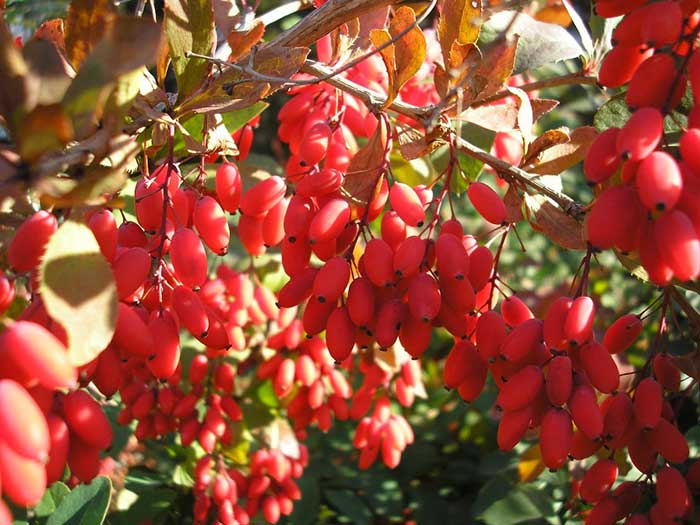
Barberry ordinary
The leaves of this type of culture are formed on the shortened shoots. The shape of the plates is elliptical or obovate. Leaves are usually small. In width, on average, they reach 2 cm, and in length - 4 cm. In the summer, the bushes do not constitute anything special in external design, but in the autumn such plants have no equal in beauty. Foliage acquires a red-burgundy or saturated scarlet shade, attracting attention.
In the barberry common creeping type of rhizome. That is why it is located in the surface layer of the soil. Over the years, rhizome woody. As for the bark, the trunks of this culture are distinguished by a light brown tinge.
Features of flowering and the fruit of the barberry ordinary
The flowering of the barberry is common in April-May. At the same time just laid the brush. They consist of 15-25 flowers of a yellowish shade. By its nature, culture is an excellent honey plant. Plus the shrub looks very beautiful during the flowering period, which lasts about 3 weeks.
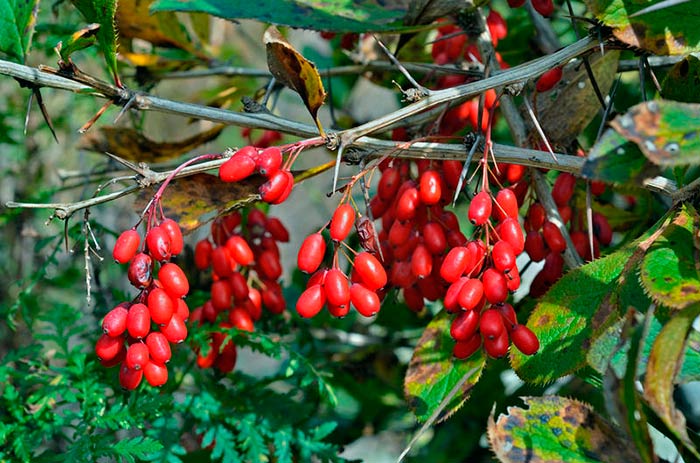
Barberry berries
In the beginning-middle of autumn, on the place where there were flowers in the spring, berries are formed. The fruits are different:
- red tint;
- oblong shape;
- sour-tart taste;
- average weight about 4 g;
- about 1.5 cm long
Council Unripe berries are strictly forbidden to eat! Due to the high content of alkaloids in the fruits, they are poisonous.
Barberry of Ottawa
One type of barberry is the Ottawa culture. This variety belongs to the number of decorative hybrids. It is derived from the ordinary type and version of Thunberg. This representative of the group is very beautiful and spectacular in appearance. Its height is on average 2 m. The leafy plates of this plant are distinguished by a purple saturated shade. Moreover, some of them vary in color from black to pink and violet. Especially beautiful leaves of this shrub shimmer in the sun. In the autumn period, the plates acquire a crimson hue. Thanks to this particular representative of the group, the bush becomes a luxurious decoration of the homestead territory.
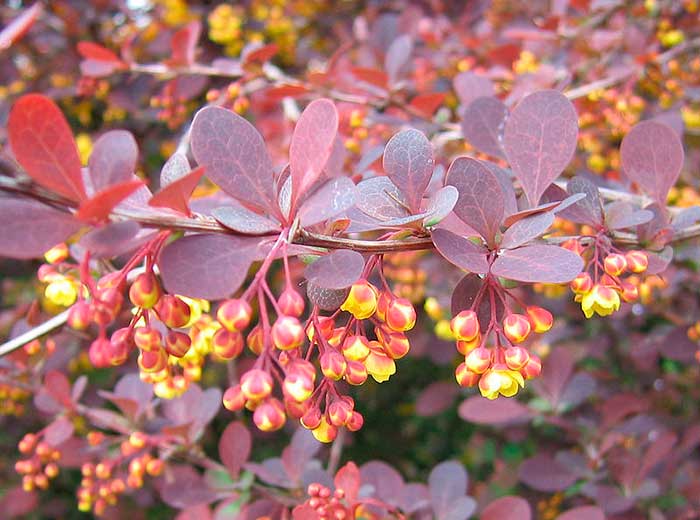
Barberry of Ottawa
Ottawa barberry has other unique features. Experienced Gardeners note that this plant is winter-hardy. It is growing rapidly and does not cause any difficulties in the care.
Varieties of Barberry Ottawa
There are several varieties of this type of barberry:
- "Superba."
- "Auricom".
- Silver Miles.
Each of them has unique features. For example, the variety “Superba” is able to grow up to 4 m. Leaf plates reach a length of 3-5 cm. Their shape is round, and the shade is dark red with bluish tints and a slight bloom. In the fall, this shrub can not be overlooked. Its sheet plates are painted in all shades of red and orange. Berries varieties "Superba" red and collected in compact brushes.
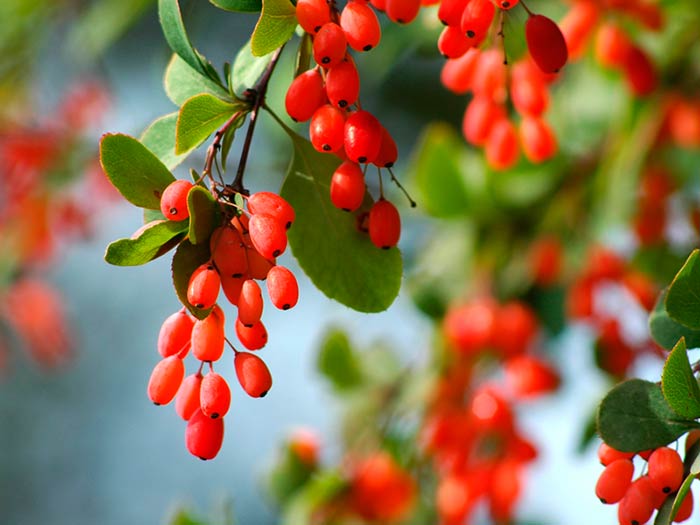
The most common barberry
Another variety of Ottawa barberry is called "Auricom". This variety forms berries of a rich red color. Fruits gather in inflorescences that resemble a brush in shape. Their length is usually 5 cm. The height of the bush itself reaches 2.5 m. Leaf plates of the variety are usually always bright red. The time of year has no effect on color.
Silver Miles is another variety of this barberry. Particularly impressive plant looks from afar, because the leaves are purple shade with grayish blotches seem lilac.
Barberry Thunberg
Another common type of shrub is Thunberg barberry. This type is also represented by several varieties, each of which has its own unique features. But there are some common properties this plant. So, it is worth noting the small height of the bush. It usually varies from 50 cm to 1 m. Shoots differ arcuate slope, bright red or yellowish tinge. They stretch in a horizontal position. Over the years, the branches become brownish-purple or brown.
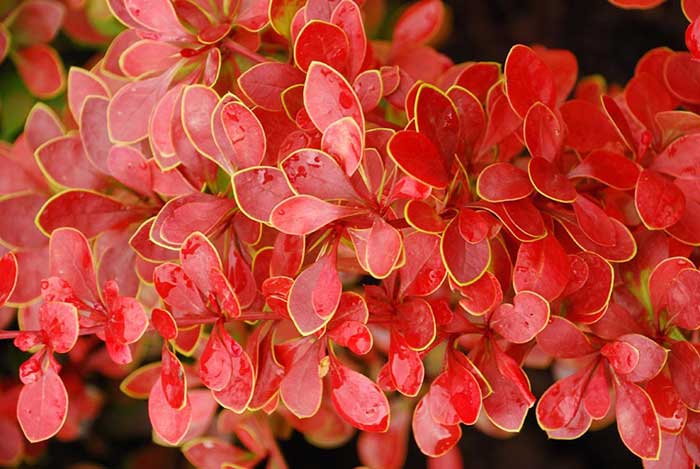
Barberry Thunberg
The barberry of Thunberg is a thorny shrub. Its thorns are quite elastic and thin, and in length they can reach 1 cm. The leaves of the plant are very beautiful. They are usually small and oblong.
The most famous varieties of barberry Thunberg
There are several varieties of this plant. One of the most popular is the Red Pilar. The height of this culture reaches 1.5 m. The width of the crown is usually 45 cm.
Another popular variety is the Golden Ring. This sort of barberry of Thunberg is distinguished by a rounded crown, large height (up to 3 m), original leaves. The plates of this plant have a red tint with purple tints and a yellow border. Flowers of a bush are collected in bunches. On the inside, they are yellow. Their outer side is red. The berries ripen in mid-autumn and are coral-colored.
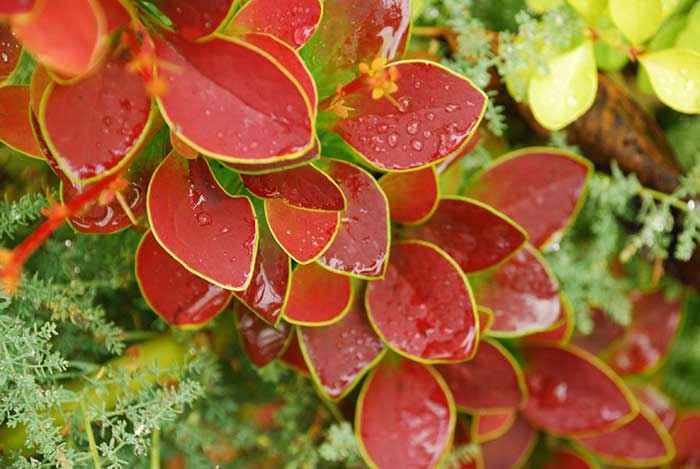
Barberry Thunberg grows up to 3 meters
As you can see, the barberry is a surprisingly versatile culture, represented by several species. In addition to these types, it is also customary to distinguish similar, transparent, Amur, oblong, spring, gray-white, Siberian, Asian, whole, willow, Iberian, oriental and many other species.
Growing barberries - video
Types of barberry - photo
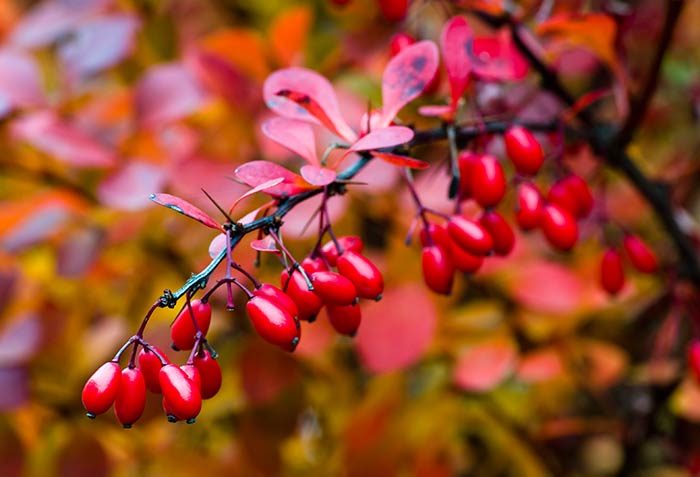

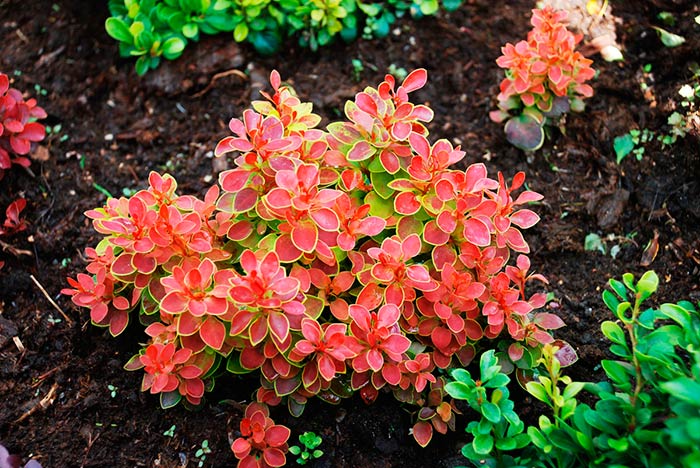
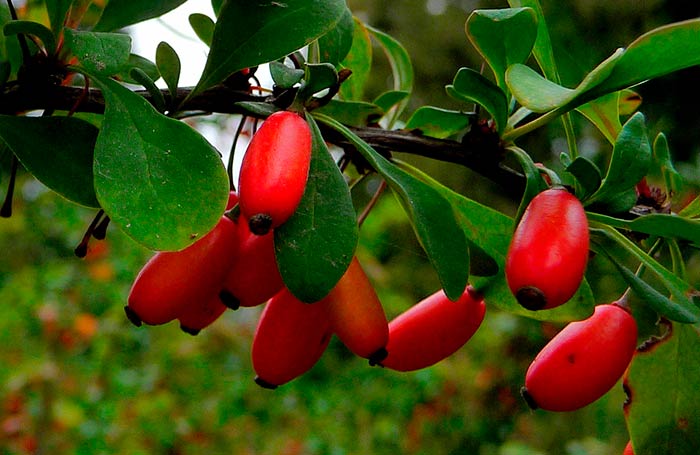
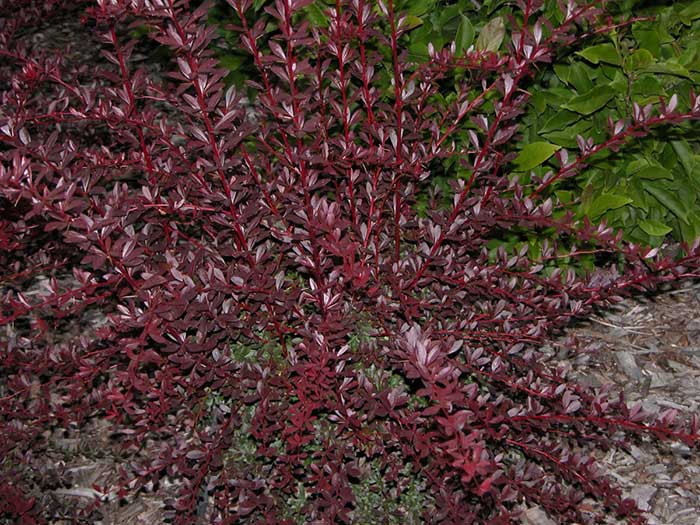
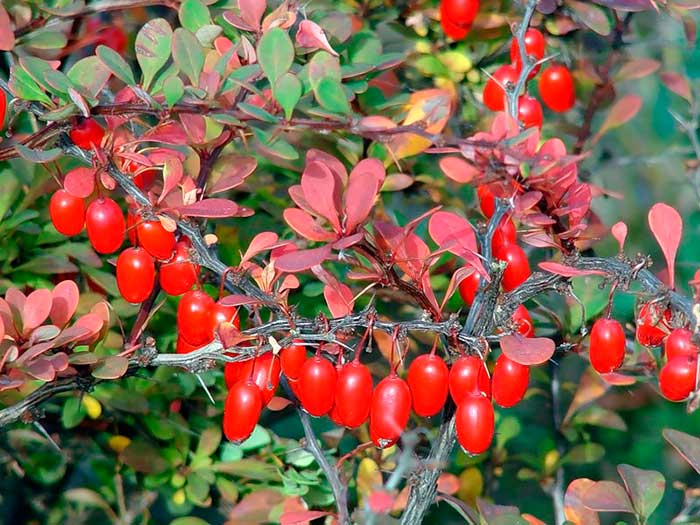
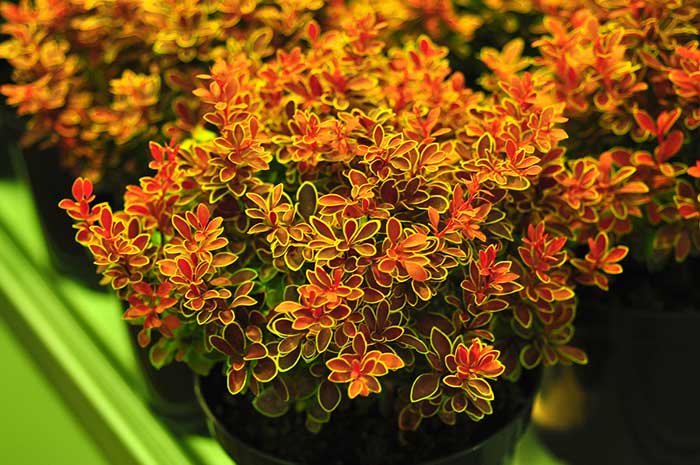
Barberry plant shrub. Barberry species have a huge amount, they differ in appearance and properties. Today we will tell about the barberry varieties, we give their photos and descriptions.
What are the types of barberry
The barberry family has a huge number of barberry species - almost 180 species, which are usually found in Central Asia, South America, China and the Himalayas. Among them are different forms, such as deciduous and evergreen barberry bushes with a variety of needles.
In this article I would like to tell you about the three most popular varieties barberries, which are used in their gardens and gardeners, and ordinary people. These are types of barberry - ordinary barberry, barberry Ottawa and Thunberg. Now a detailed description of each of these varieties of barberry.
Barberry variety - description, photo
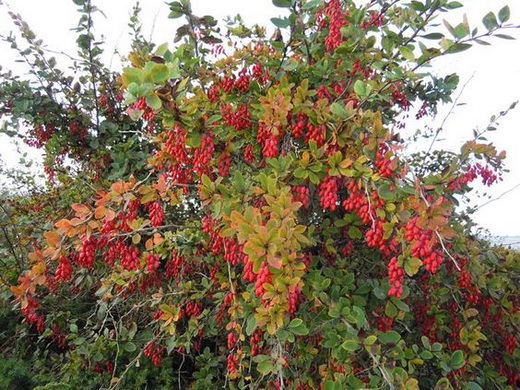
The barberry is frost, drought, and gas resistant under normal conditions. This type of barberry is not very picky about the soil, so you can easily find a place for planting and do not need extra efforts to care for them. There is also this species of barberry interesting varieties that are outwardly different in some ways.

For example, in the barberry species Berberis vulgaris f. Aureo-marginata leaves are framed with a golden rim, which, of course, will be appreciated even by people just walking past.
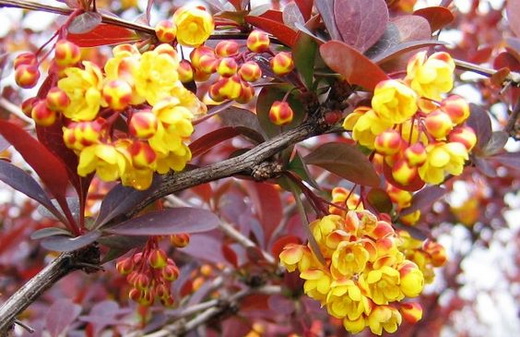
In the barberry variety Berberis vulgaris f. atropurpurea leaves are quite dark, saturated purple, and the bush itself can sometimes grow up to two or two and a half meters.
If you are attracted by the original color of the barberry with white spots and stripes, you can safely choose the type of barberry called Berberis vulgaris f. Alba-variegata. Also, the barberry can have different variations of the possible color of fruits: both white and yellow.
Description of barberry Thunberg
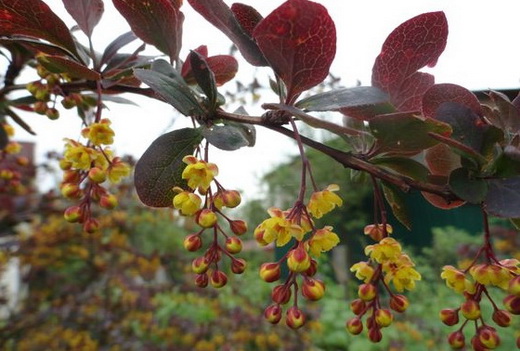
Barberry of the Thunberg species hails from China and Japan. It grows to a height of one and a half meters. It is a green plant, but also has its own varieties, in which the colors are significantly different. The barberry of this variety is great for building a so-called hedge, or even for so-called walls that divide the land into several parts. Looks great, as well as in a group with other plants, and singly. By the way, if you decide to make such a layout of the garden in the Japanese style, you can safely pick up this sort of barberry. No wonder Japan and China are his homeland. In the fall, he acquires a very interesting coloring: one tree can be of several colors at the same time, ranging from orange-red and ending with purple.
As for the types of this barberry variety, everything is also very interesting here.
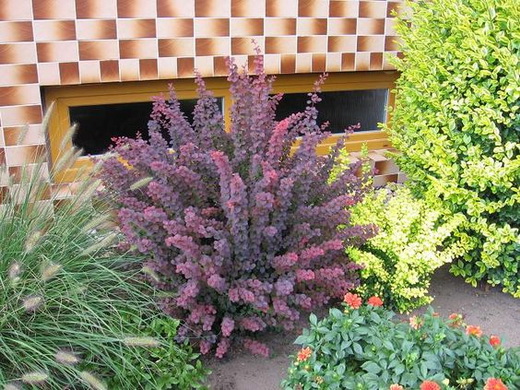
Photo: Barberry Berberis thunbergii f. Atropurpurea
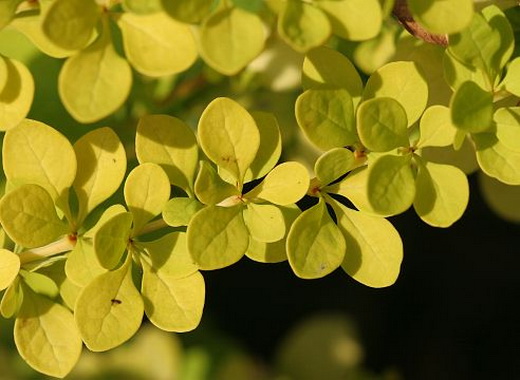
Photo: Barberry Berberis thunbergii f. Aurea
Some species (like Berberis thunbergii f. Atropurpurea and Berberis thunbergii f. Aurea) have a height of up to one and a half meters, but at the same time a completely different color of leaves: purple-violet and golden-yellow, respectively.
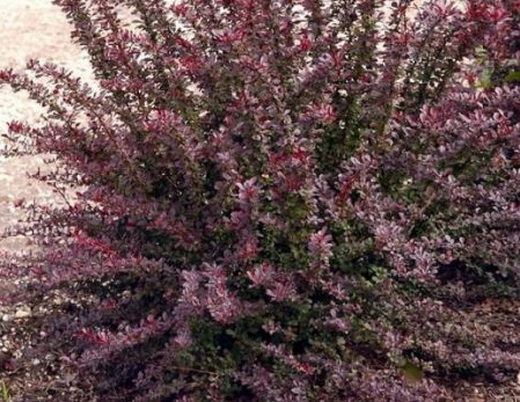
The type of barberry Berberis thunbergii "Red Chief" is red in color, and it dissolves the side branches well, which gives it additional volume.
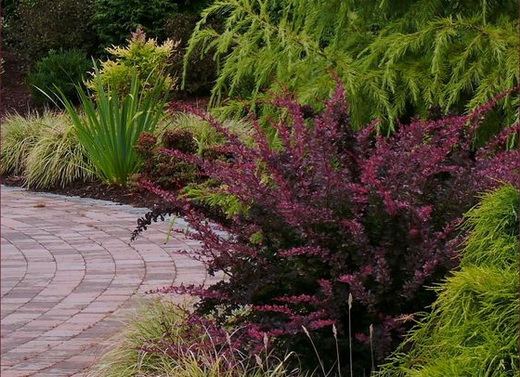
If you need a neat and small barberry for a garden, buy a variety of Berberis thunbergii "Red King", it will be an excellent blood-red highlight of the garden.
Variety of Barberry Ottawa - description and photo
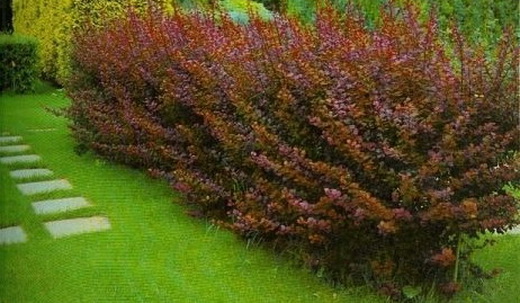
As for the third type of barberry Ottawa - you can talk about it for a very long time. Of course, its disadvantage is that in nature this sort of barberry almost does not occur, but thanks to its elegant forms and large growth (up to 2 meters), it will be able to decorate any yard.
Video: Varieties and varieties of barberry
The ornamental shrub barberry with unusually tasty and healthy fruits is a real godsend for the summer resident. Add to this the extremely high medicinal properties of its berries. Do not forget about the ease of care, and the cultivation of barberry will be almost mandatory on each household plot. Indeed, a rare gardener is able to abandon this beauty with such high qualities!
Description of barberry and how to use it
To get started, check out the photos and descriptions of the barberry belonging to the Barberry family. In total, more than 170 species are known, naturally growing mainly in East and Central Asia, South America. In our country, three species are found in the wild: Amur barberry in the Far East, Siberian barberry in the Altai and Sayan mountains, ordinary barberry in most of the European territory.
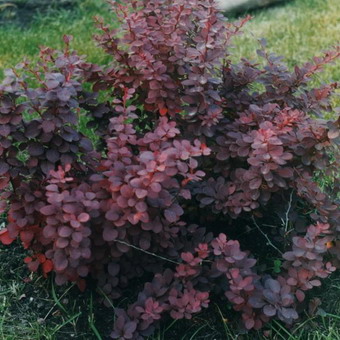

Barberries - it is prickly deciduous, less often evergreen shrubs, strongly differing from each other in height, shape, color of leaves and fruits. The leaves are simple, spiky along the edge. They bloom in late May - early June with yellow or pale orange flowers with a specific smell that attracts bees.
As can be seen in the photo, the flowers of the barberry shrub are usually collected in racemes of up to 10 cm:
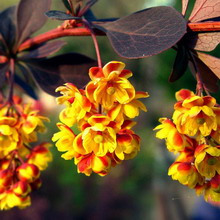 |
 |
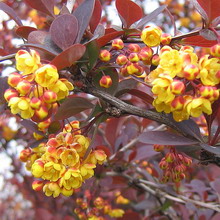 |
 |
 |
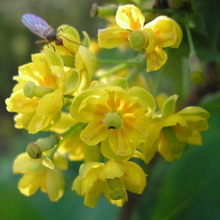 |
 |
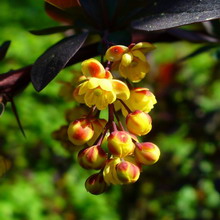 |
 |
In September - early October, the fruits ripen. In most species, they are small, oblong, up to 1 cm long, bright red, edible with a sweet-sour taste. Only in some barberries the berries are black with a bluish bloom. Barberry Thunberg fruits are inedible. In early September, simultaneously with the ripening of the fruit, the leaves of the barberry change color, acquiring various shades of saturated red, less often yellow.
Barberry deserves attention and how. Fresh and dried berries are used for coloring wine. Compotes are prepared from the fruit, jams, kissels, mousses, and sour seasoning for meat, making marshmallow and sweets. Use in the food and young leaves, rich in vitamins and having a pleasant sour taste.
How else is used barberry grown in culture or growing in natural conditions? This shrub is used in the course of almost all parts of the plant. Broth from bark and roots paint skin and wool in lemon-yellow color. Extract from the fruit with the addition of alum color flax, cotton and wool in pink hues. Solid, dense, with a beautiful texture barberry wood is appreciated, it is used for inlays, mosaics, small handicrafts. An alkaloid has been isolated from the plant, on the basis of which certain medications have been created.
Types of barberries with photos, names and descriptions
AT middle lane Only deciduous barberries are promising. Below you can see the photos and the names of the popular types of barberry, as well as their description.
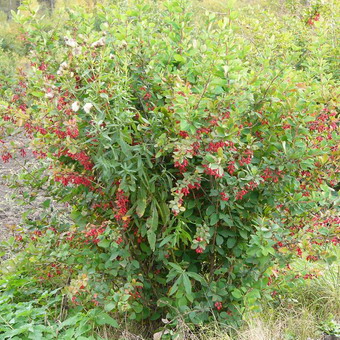
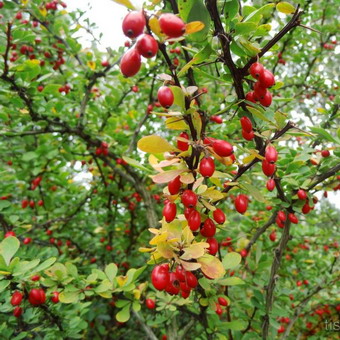
Barberry ordinary. Shrub up to 2.5 m, with ribbed young shoots. It looks very impressive during the flowering period, when the plant is completely covered with drooping tassels of small yellow flowers. Barberry shrubs of this species are colored for two weeks in May-June. Edible fruits ripen in September. In autumn, the leaves turn orange-red and the brush of purple berries looks very beautiful against their background.
Especially decorative is the purple form of the barberry common Atropurpuria. The dark purple color of the leaves is fully evident when grown in a sunny open place. The lack of barberry ordinary - a strong susceptibility of rust fungus, dangerous for cereals, therefore, the use of this species in countryside limited.
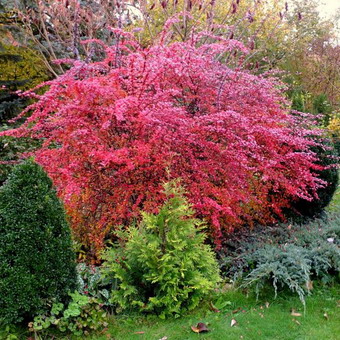
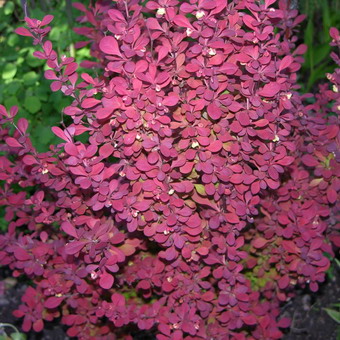
Barberry Thunberg. Originally from Japan. Low (up to 1.5 m) shrub with a dense crown and arcuately curved shoots. The leaves are small, bright green, in autumn are painted in bright red-purple color. It blooms in late May - early June, for three weeks. The flowers are yellow, reddish orange outside. Fruits up to 1 cm long, bright red, shiny, elongated, inedible, long stored on the plant. Resistant to rust fungus.
There are numerous forms of barberry Thunberg, characterized by high decorative. The purple form of Atropurpuria is quite well known. It is less winter-hardy than the main species, and requires shelter for the winter.
The dwarf form of Atropurpurean Nana forms a compact, rounded, slightly narrowing bush, with a height of no more than 0.5 m:
Look at the photo - in this type of barberry the foliage in autumn becomes golden-scarlet:
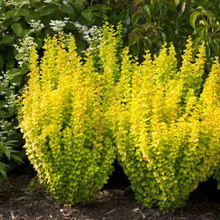 |
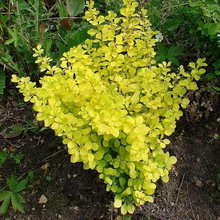 |
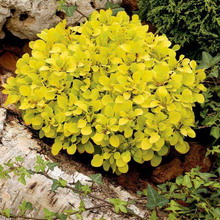 |
 |
 |
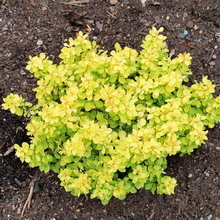 |
 |
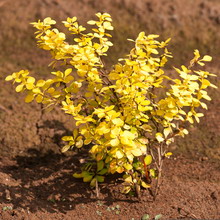 |
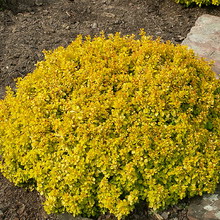 |
Unusually attractive undersized (up to 50 cm) barberry Thunberg Aurea with bright, shiny, lemon yellow or golden yellow foliage. Noteworthy is the variegated form with white spots and streaks (bush height 1.0-1.4 m).
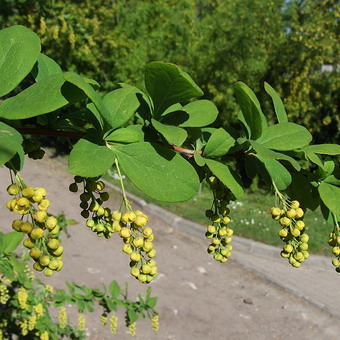
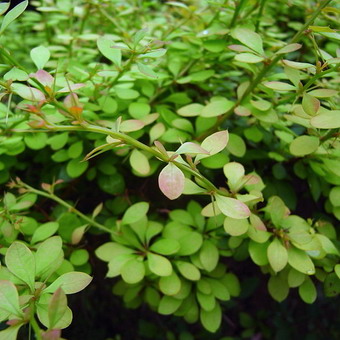
Korean barberry. In the wild form is distributed on the Korean Peninsula. Shrub up to 2 m high with straight shoots, with large, slightly wrinkled, semi-leather, shiny leaves. Yellow flowers are collected in brushes of 10-25 pieces. It blooms in late May - early June. The duration of flowering of this type of barberry shrubs is 15-20 days. The fruits ripen in September and October. They are egg-shaped, bright red, long on the branches. Winter hardy
Growing barberries: planting shrubs, care and pruning in spring
A necessary condition for the cultivation of barberry - the presence of sunny places where the decorative coloring of the foliage is fully manifested. They can put up with a slight shade. They are not very demanding to the soil, they are quite satisfied with the poor with a low content of humus. When caring for barberry shrubs, do not forget that these plants do not tolerate stagnant moisture. Drought resistant. Most species tolerate low winter temperatures satisfactorily.
Barberry is propagated by seeds and vegetatively (green cuttings, dividing the bush, layering). Barberry shrubs are planted in the fall with freshly harvested seeds or in spring after pre-stratification. Shoots appear in the first year. The barberry grows slowly at first - 10-15 cm per year, some species - 3-4 cm, then the growth increases. Flowering and fruiting begins from 4 to 5 years. Biennial seedlings are planted on permanent place fall or spring. Planting pits are prepared in size 40x40x40 cm. Barberries are well tolerated by transplants. Green cuttings root in the summer in a cold greenhouse.
Used for single and group plantings, hedges, it is suitable for. Barberry is ideal for protecting the soil from erosion on open rocky slopes. Low-growing decorative forms can be used for tamping groups of tall shrubs, including barberry, as over time, the lower part of the bushes becomes bare.
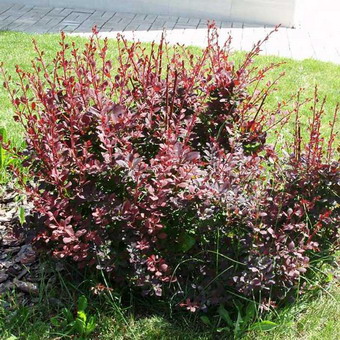
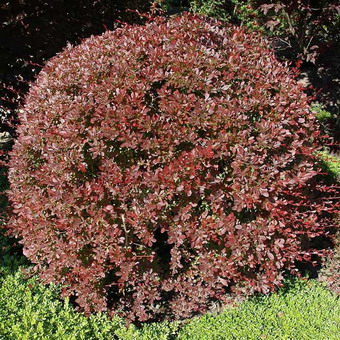
Barberry tolerates a haircut, the bush can easily give the desired shape and height. Cut the plants better after flowering, shortening the shoots by no more than half. Damaged or excess branches are removed in early spring. from the barberry it turns out to be dense, difficult to pass because of the many thorns. In addition, the plant does not give abundant root shoots, from which it is subsequently very difficult to get rid of. Hedge it is not necessary to cut from the barberry; you can choose those species whose height in adulthood corresponds to the desired height of the fence. Over time, the bushes have to rejuvenate, as they begin to develop weak and short shoots with small leaves and flowers. To rejuvenate, pruning barberries is carried out in the spring to a height of 5-10 cm. Dormant buds awaken on stumps and over the summer young strong shoots grow. Next spring, the remaining old shoots are cut in the same way.

